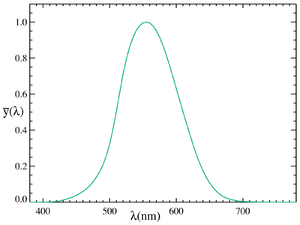
The 1931 CIE luminosity function. The horizontal axis is wavelength in nm.
The luminosity function is a standard function established by the Commission Internationale de l'Éclairage to account for the variable sensitivity of the human eye to radiation at different wavelengths. It converts radiant energy into luminous (i.e. visible) energy. It also forms the central color matching function in the CIE 1931 color space.
For the standard conditions chosen in establishing this standard luminosity function (photopic vision), the luminous flux, L, in lumens is given by
where is the standard luminosity function, and is the spectral intensity of the radiation, in watts per unit wavelength
The standard luminosity function is normalized to a peak value of unity at 555 nm (see luminous coefficient). The value of the constant in front of the integral is usually rounded off to 683 lumens/watt. The small excess fractional value comes from the slight mismatch between the definition of the lumen and the peak of the luminosity function. The lumen is defined to be unity for a radiant energy of 1/683 watt at a frequency of 540x1012 Hz, which corresponds to a standard air wavelength of 555.016 nm rather than 555 nm, which is the peak of the luminosity curve. The value of is 0.999997 at 555.016 nm, so that a value of 683/0.999997=683.002 is the multiplicative constant (Wyszecki & Stiles, 2000).
Scotopic Luminosity[]
For very low levels of intensity (scotopic vision), the sensitivity of the eye shifts toward the violet, peaking around 507 nm for young eyes; the sensitivity is in some sense equivalent to 1746 lumens/watt at this peak[citation needed].
References[]
- Wyszecki, Günter and Stiles, W.S. (2000). Color Science - Concepts and Methods, Quantitative Data and Formulae, 2nd edition, Wiley-Interscience. ISBN 0471399183.
he:העקומה הפוטופית
| This page uses Creative Commons Licensed content from Wikipedia (view authors). |


